Corsair Force GT Series and Corsair Force 3 Series Review

We have recently received two more SSD drives from Corsair based on the second generation SandForce controller. Let’s check out their performance and also investigate how SSD speed scales depending on their storage capacity.
Our recent comparative review of solid state drives based on the SandForce SF-2281 controller proved that there are performance-relevant factors other than the controller itself. The choice of NAND flash memory and its architecture can also be highly important. The SF-2281 being an eight-channel controller, the majority of SSDs (except for entry-level models with a capacity of less than 120 gigabytes) utilize all eight. However, the number of chips and NAND devices on each channel can affect the resulting performance, too. Roughly speaking, the more flash memory devices are connected to each controller channel, the better. This is just how the internal algorithms of the SandForce controller work.
One consequence is that the SF-2281 makes SSDs faster as they grow larger in storage capacity. You may have noticed that specifications of 240GB SSDs are higher than those of their lower-capacity cousins. That’s not just a marketing trick serving to promote large-capacity products. Practical tests indicate that 120GB SSDs indeed find it hard to compete with 240GB ones. That’s why Corsair’s Force 3 and Force GT disks weren’t brilliant in our previous review. These series were just represented with lower-capacity models which fell behind their 240GB opponents (OCZ Vertex 3 Max IOPS, Kingston HyperX and OCZ Agility 3). We now want to make our amends to Corsair as the company has provided us its 240GB Force 3 and Force GT products.
So, in this review we are going to see the difference between solid-state drives of different storage capacities, taking the SandForce-based Corsair Force 3 and Force GT series as an example.
Let’s first take a look at each product we’re going to test.
Corsair Force Series 3 240GB
Corsair’s entry-level Force 3 series is based on a second-generation SandForce controller. The low performance of the inexpensive NAND flash memory of this SSD is supposed to be masked by the controller’s advanced operation algorithms. Being one of the key features of the SF-2200 series, the algorithms ensure on-the-fly data compression in order to keep the data-transfer rate high even with slow flash memory. Moreover, this allows to increase the reserve space to improve the SSD’s reliability. The resulting product offers acceptable performance at $1.3 to $1.4 per one gigabyte of storage, which is a real bargain.
The Corsair Force 3 240GB is shipped in a small, demurely designed box.
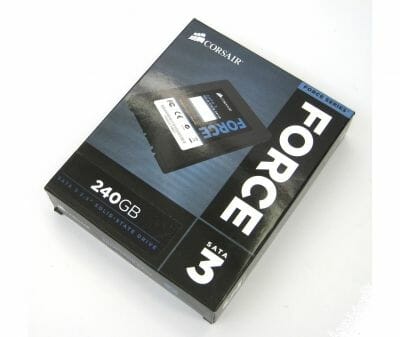
Besides the SSD proper, the box contains a guide with fasteners for installing this 2.5-inch device into a 3.5-inch disk bay.
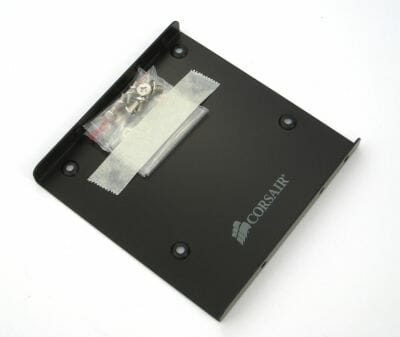
The SSD itself is black and serious.
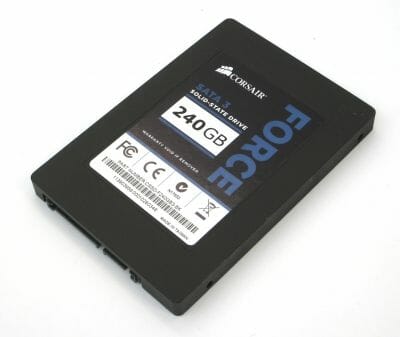
The most interesting things are inside, of course. We mean its PCB.
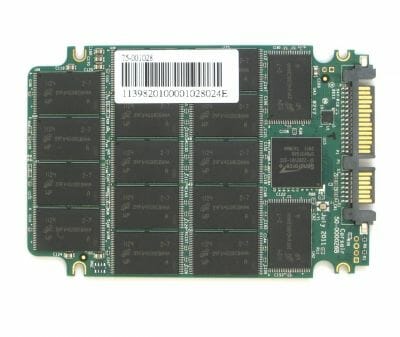
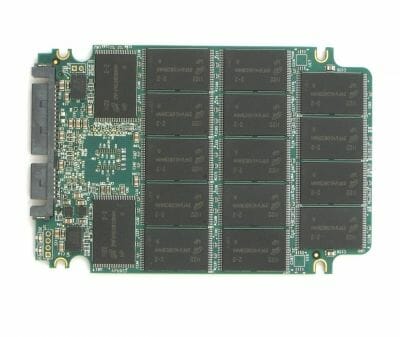
The SandForce controller is surrounded with as many as 32 memory chips which are made by Micron and labeled as 29F64G08CBAAA. However, some batches of this SSD may come with other ONFI 2.2 compliant chips with the same specs. Each of these 25nm flash memory chips has a capacity of 64 gigabits and asynchronous interface. In other words, this is the same memory as in the 120GB model from the same series. Hidden from the user, 16 out of the total 256 gigabytes are used as reserve space. Thus, each controller channel is connected to four flash devices, enabling 4-way interleaving.
By the way, we’re referring to the controller as SandForce SF-2281 but the actual chip is marked as SF-2282. This is no mistake because the latter only differs from the former in packaging and support for 128-bit NAND devices.
The Corsair Force 3 comes with firmware 1.3.3 which is based on SandForce’s reference firmware 3.3.2. The developer says that this firmware version finally solves all the problems with BSODs that plagued the controller for half a year since its release.
Here are the official specs of the 240GB Corsair Force 3:
- Controller: SandForce SF-2282
- Interface: SATA 6 Gbit/s
- Flash memory: asynchronous NAND
- Capacity: 240 gigabytes
- Cache memory: n/a
- Sequential read speed: 550 MB/s
- Sequential write speed: 520 MB/s
- Random write speed (in 4KB data blocks): 85,000 IOPS
Corsair Force GT 240GB
This is Corsair’s high-performance series based on the SandForce SF-2281 controller. There is no saving on components here, so the SSD employs synchronous flash memory to deliver maximum speed. The downside of this type of NAND flash is that the cost per gigabyte is as high as $1.7.
The packaging of the Force GT is the same size and shape as that of the Force 3 but colored slightly differently. Moreover, the manufacturer proudly declares the peak speed of the SSD right on the face side of its box.
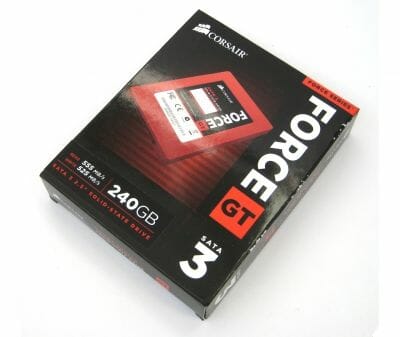
The box contains the same stuff as we’ve seen with the more affordable Corsair.
To emphasize the high class of the Force GT series, Corsair implements these SSDs in an eye-catching red case.
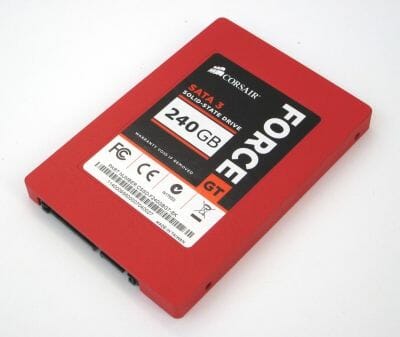
The PCB of the 240GB Force GT is significantly different from what we saw inside its 120GB cousin tested some time ago. It is somewhat smaller but the number of flash memory chips is identical.
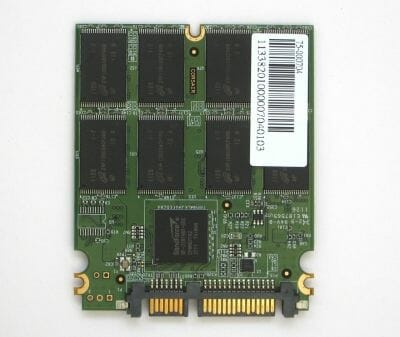
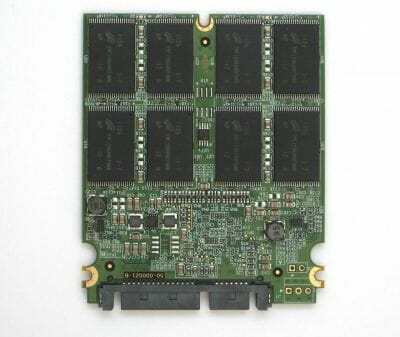
As you may have guessed, that’s because the chips are 128 rather than 64 gigabits in capacity. They are manufactured by Micron. Each chip contains two semiconductor dies, one above the other. This memory has synchronous ONFI 2.2 interface with a data-transfer rate of 166 MT/s. As a matter of fact, the 240GB Corsair Force GT has the same memory specs as the Kingston HyperX, one of the leaders of our previous comparative test. There are four NAND flash devices per each controller channel in this Force GT, so it can use 4-way interleaving, just like its 240GB cousin from the Force 3 series.
The Force GT’s firmware 1.3.3 is based on the latest version of the reference SandForce firmware. Hopefully, SandForce has indeed eliminated all the critical bugs which used to plague SSDs with the SF-2281 controller. The failure rate of Corsair SSDs is rather low at 2.9% (according to European retailer data), yet this number is three times as high as that of Crucial and Intel SSDs. Fueled by forum discussions, this contributes to creating an aura of unreliability about SandForce. Hopefully, SandForce and Corsair will get rid of it, now that they’ve got the problem-free firmware.
Here are the official Corsair Force GT 240GB specs:
- Controller: SandForce SF-2281
- Interface: SATA 6 Gbit/s
- Flash memory: synchronous NAND
- Capacity: 240 gigabytes
- Cache memory: n/a
- Sequential read speed: 555 MB/s
- Sequential write speed: 525 MB/s
- Random write speed (in 4KB data blocks): 85,000 IOPS
Although there are but minor differences from the Force 3 240GB, the GT series features MLC memory which is fast by itself, without relying on the SandForce controller’s compression algorithms. Let’s see how fast it is, exactly.
Testbed and Methods
The testbed we are going to use for this test session is based on a mainboard with Intel H67 chipset which offers two SATA 6 Gbit/s ports. It is to these ports that we connect our SSDs. Here is the full configuration:
- Intel Core i5-2400 (Sandy Bridge, 4 cores, 3.1 GHz, EIST and Turbo Boost turned off)
- Foxconn H67S mainboard (BIOS A41F1P01)
- 2 x 2 GB DDR3-1333 SDRAM DIMM 9-9-9-24-1T
- Crucial m4 256 GB system disk (CT256M4SSD2)
- SSDs:
- Corsair Force 3 Series 120 GB (CSSD-F120GB3-BK)
- Corsair Force 3 Series 240 GB (CSSD-F240GB3-BK)
- Corsair Force GT Series 120 GB (CSSD-F120GBGT-BK)
- Corsair Force GT Series 240 GB (CSSD-F240GBGT-BK)
- Crucial m4 256 GB (CT256M4SSD2)
- Kingston HyperX 256 GB (SH100S3/240G)
- OCZ Agility 3 240 GB (AGT3-25SAT3-240G)
- Microsoft Windows 7 SP1 Ultimate x64
- Drivers:
- Intel Chipset Driver 9.2.0.1030
- Intel HD Graphics Driver 15.22.1.2361
- Intel Management Engine Driver 7.1.10.1065
- Intel Rapid Storage Technology 10.8.0.1003.
Performance Secret – Interleaving
Corsair’s 240GB SSDs rely on 4-way interleaving in delivering higher performance compared to their lower-capacity cousins. The point of interleaving is that there can be from one to eight NAND flash devices (chips) connected to a single channel of the SandForce controller. The latter can access those devices individually. So when one of the flash memory chips is busy doing some operation (which can take up to a few cycles to complete), the respective controller channel does not stay idle but is used to access another memory chip. This full utilization of all controller channels leads to higher performance. The technique is most effective for writing, masking the latencies associated with storing data into flash memory.
Thus, the more NAND devices per channel the controller has, the higher performance it can deliver. Considering that the typical capacity of a single 25nm flash memory die is 64 gigabits, the level of interleaving increases along with the capacity of the whole SSD. For example, 240GB SSDs with modern 25nm flash contain 32 NAND devices, which means 4 such devices per controller channel. That’s why the Force GT and Force 3 series products we are going to test today make use of 4-way interleaving.
Interleaving does not multiply performance, though. Why? Well, first of all, it is just not possible at all in some situations, for example at reading. And even when erasing and writing data, the controller has to access flash chips in each channel one by one rather than in parallel, so some delays are unavoidable.
You can’t estimate the effect of interleaving basing on theoretical assumptions only, so we carried out a practical test to compare 120 and 240GB versions of Corsair’s Force 3 and Force GT SSDs. We used CrystalDiskMark 3.0.1 as it allows benchmarking SSDs with incompressible random data as well as with compressible predefined data. Therefore, there are two numbers in the diagrams: the maximum and minimum speed of each SSD. The real performance is going to be in between these two numbers and depend on how well the SF-2281/SF-2282 controller can compress data.
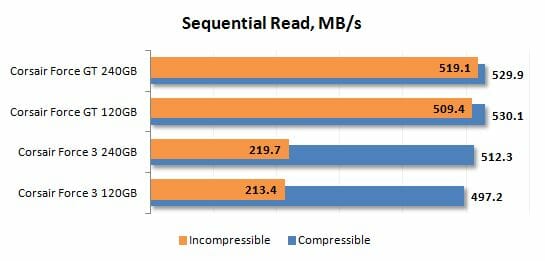
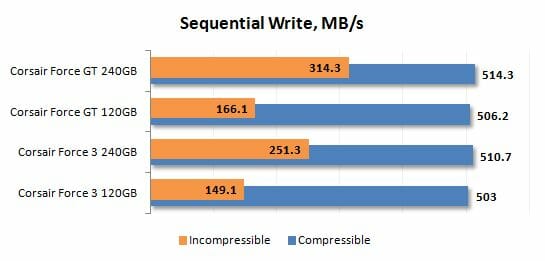
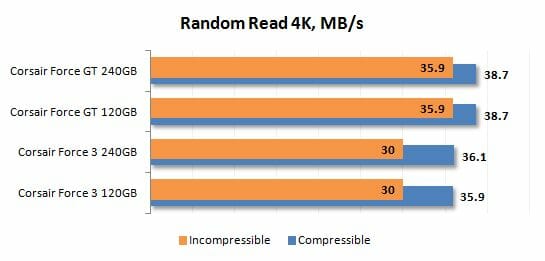
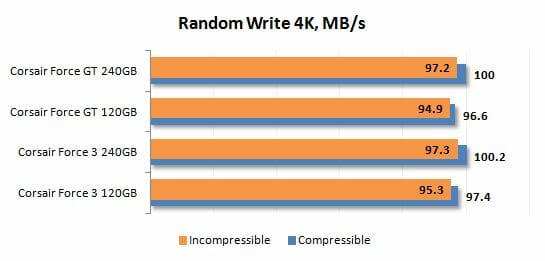
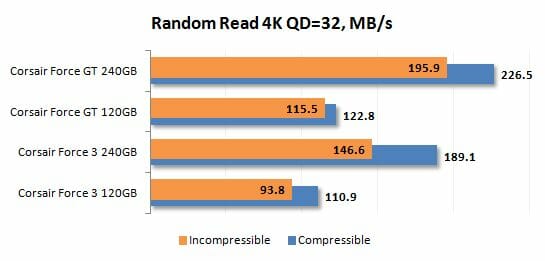
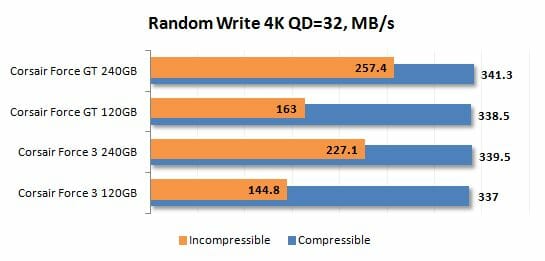
The 4-way interleaving implemented in the 240GB SSDs really makes them faster, especially at sequential writing. The performance boost is 70 to 90% depending on flash memory type (asynchronous or synchronous), but you can only achieve it with incompressible data. When it comes to compressible data, the SF-2281/SF-2282 controller can successfully mask the difference between fast and slow varieties of flash memory.
Interleaving also improves the speed of random-address access with a long request queue. Random reading and writing are both accelerated, and the random read speed even improves with incompressible data. The performance gain varies from 55 to 85%, being more noticeable with the faster Force GT series. As for ordinary random-address reading and writing, the larger-capacity SSDs with higher level of interleaving do not have any advantage then.
So, it turns out that Corsair SSDs from the same series have absolutely different speed specs if they have different capacities. The official specs for the 120GB and 240GB models are very close, yet the practical difference is huge from a consumer’s standpoint. The larger-capacity SSDs are much faster even though they use the same components as their lower-capacity cousins from the same series. That’s why you may want to check out not only the controller and flash memory type but also the memory architecture of the SSD you are going to buy. Besides the number of controller channels, interleaving has a huge effect on performance as you’ve just seen.
Performance
Now we can test SSDs of the same capacity (240 or 256 gigabytes). We will compare the pair of Corsair products to two other SF-2281 based SSDs with synchronous and asynchronous flash, Kingston HyperX and OCZ Agility 3. We’ll also throw in a completely different Crucial m4 SSD which is based on a Marvell 88SS9174 controller.
Random and Sequential Read/Write Speed
We measure the speed of sequential and random-address operations with CrystalDiskMark 3.0.1.
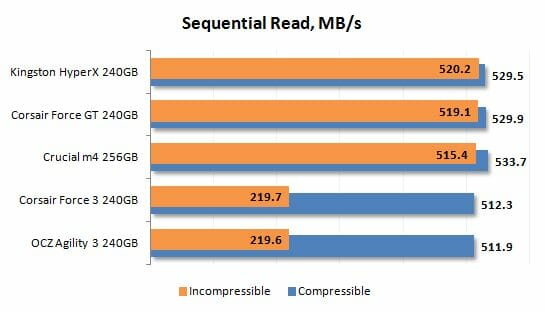
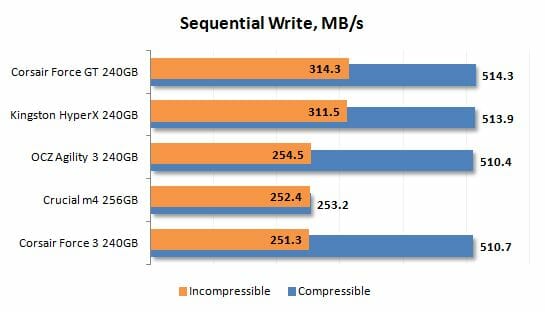
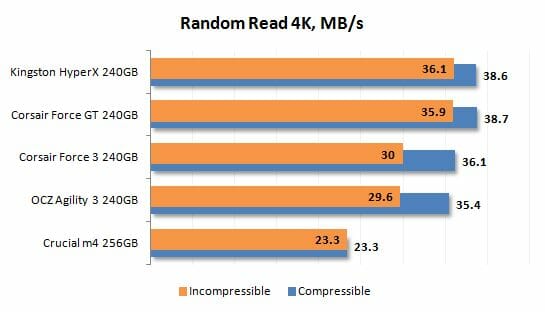
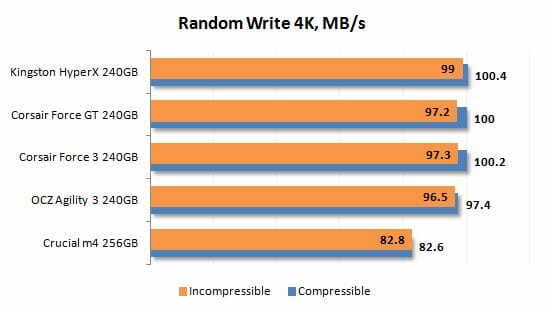
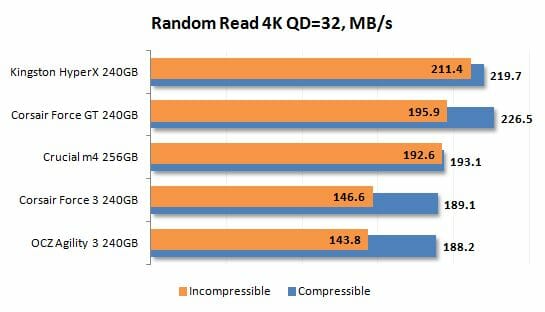
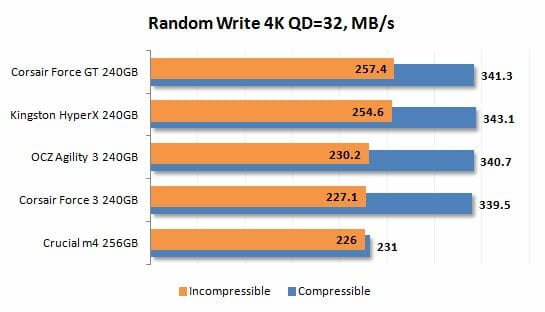
Well, everything is exactly as it should be. Same-capacity SSDs based on the SandForce SF-2281/SF-2282 controller split up into two groups: faster products with synchronous MLC flash and slower products with asynchronous flash. The gap is especially large when it comes to incompressible data. Thus, the Corsair Force GT is among the leaders while the Force 3 is among the slowest SSDs, similar to the OCZ Agility 3.
Intel IOMeter Tests
Now we will use the latest available version (1.1.0 RC1) of the synthetic benchmark IOMeter, an industry standard in testing disk subsystems. IOMeter is very functional but we will focus on the SSD-relevant characteristics only: random-address reading/writing and sequential reading/writing.
The first test is about reading and writing random-address 4KB data blocks. The request queue depth is limited to 1, but there are four independent data threads: one for each CPU core. This disk usage scenario is closer to real-life applications in a multitasking environment. The test data are pseudorandom.
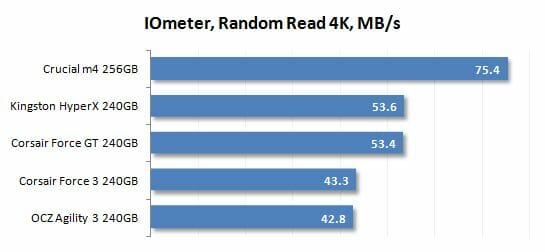
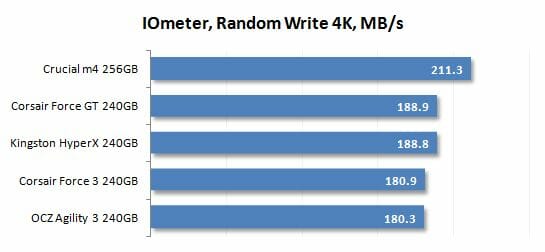
The second IOMeter test is the same except that the request queue is increased to 32 commands, which means a much higher load on the disk subsystem.
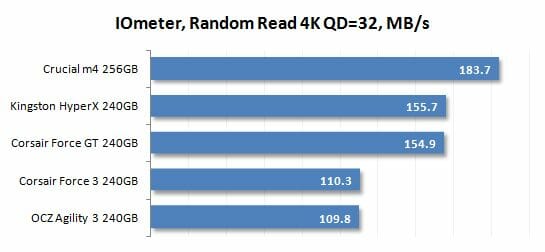
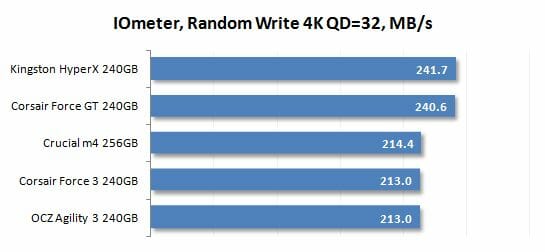
The tests with random-address data suggest that Corsair’s SSDs are practically similar to modern SandForce-based products from other brands. And like the SSDs from Kingston and OCZ, they are inferior to the Marvell-based Crucial. The fundamental difference of IOMeter from CrystalDiskMark we’ve used above is that the IOMeter tests are multithreaded. Crucial’s architecture seems to be better suited for it.
In the final test the SSDs are accessed for sequentially placed data in 128KB blocks. The test runs in a single thread at a request queue of 1. Like in the previous tests, the test data are pseudorandom.
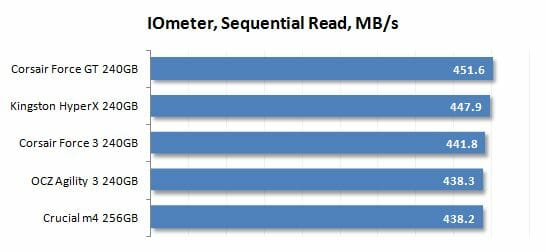
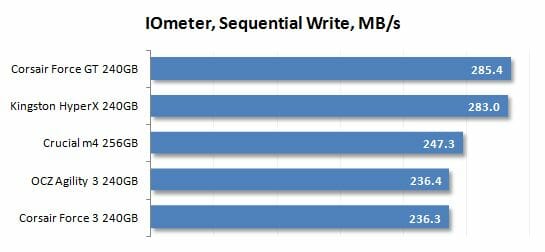
The speeds of sequential reading are almost identical but the Force GT goes ahead at sequential writing, joining the group of faster SSDs. The Force 3 is slower and similar to the OCZ Agility 3 in performance. Considering its lower pricing, the Force 3 can be said to deliver a more attractive price/performance ratio.
Futuremark PCMark 7
PCMark 7 incorporates an individual disk subsystem benchmark which is based on real-life applications. It reproduces typical disk usage patterns and measures how fast they are performed. Moreover, the disk access commands are not reproduced one by one, but with pauses necessary to process the data, just like in real life.
The benchmark reports an overall disk subsystem performance rating as well as the data-transfer rate in particular scenarios. Take note that the speed in these scenarios is rather low due to the pauses between input and output operations. In other words, PCMark 7 shows you the speed of the disk subsystem from the application’s point of view. Rather than the pure performance of the SSDs, this benchmark will show us how good they are in practical tasks.
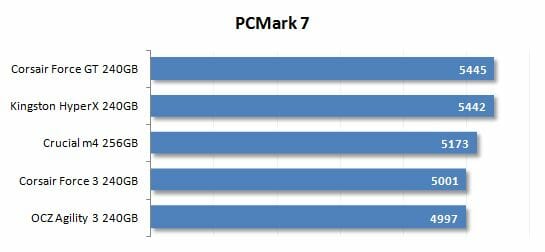
The PCMark 7 scores separate the SandForce-based SSDs into faster (with synchronous flash) and slower (with asynchronous flash) products. The Corsair Force GT belongs to the former group whereas the more affordable Force 3, to the latter. Based on a different controller, the Crucial m4 takes an in-between position.
The difference between the Force GT and Force 3 is no larger than 9%, which is not much but reflects the real situation truthfully enough. That’s the advantage you should count on if you prefer the Force GT to the Force 3.
You may want to take a look at the individual subtests. The gaps between the SSDs are quite impressive in some of them.
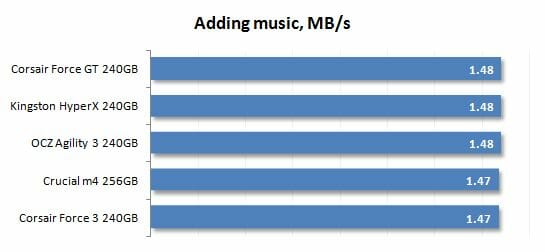
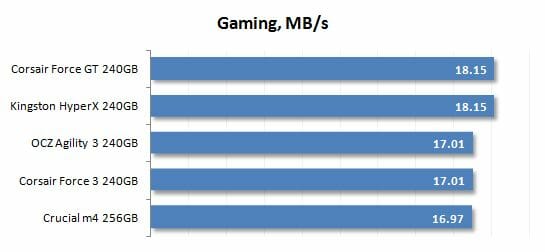
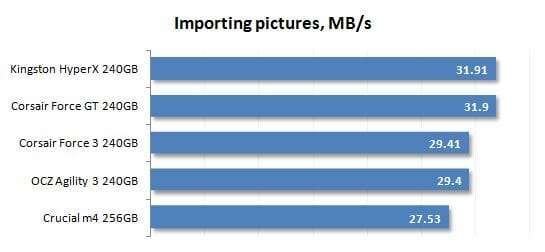
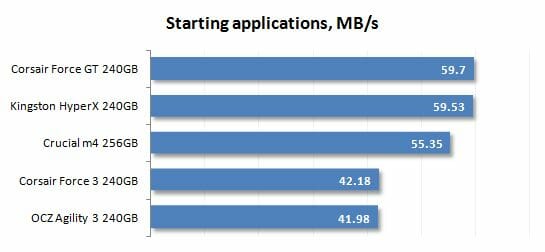
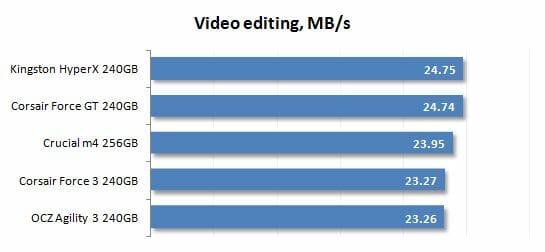
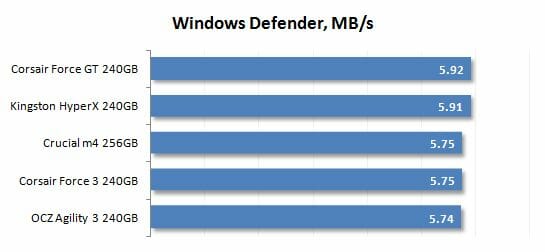
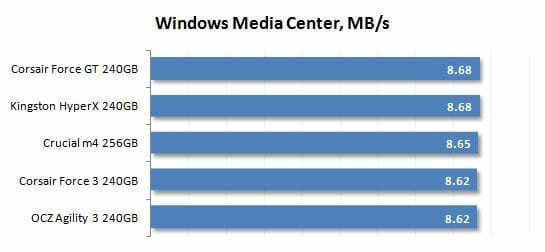
File Copying
We use AS SSD version 1.6.4237.30508 as a file copy test. This benchmark copies files within a single partition the size of the SSD’s full storage capacity.
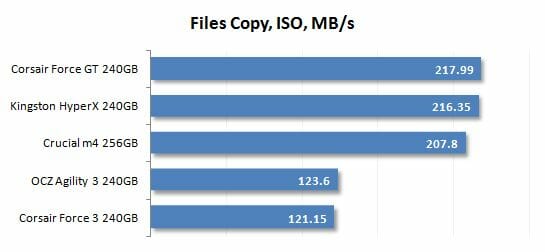
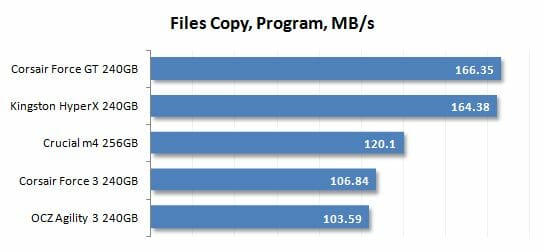
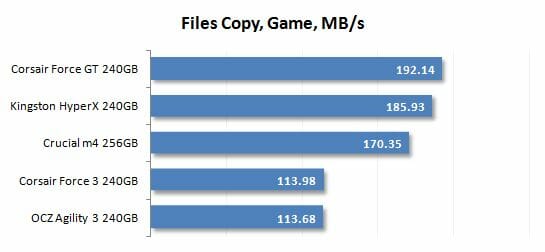
We don’t get any new information here. Like in the previous tests, the Corsair Force GT is comparable to the faster SandForce-based SSDs (and even stands out among them occasionally) whereas the Force 3 is as fast as the other inexpensive SSDs with asynchronous flash.
Conclusion
If you are choosing among SSDs based on the SandForce SF-2281/SF-2282 controller, you should consider not only its flash memory type but also its storage capacity as a performance-related factor. A larger-capacity SSD contains more flash devices, which enables interleaving, a technique that helps increase performance across different types of disk operations. The performance boost can be as high as 50% and more at sequential writing or random-address operations with a long queue depth. As a result, a 240GB SSD with slow asynchronous flash memory may turn out to be faster than a 120GB one with synchronous flash. If speed is your priority, you will have to buy a larger-capacity product.
Corsair is quite an attractive option. The company’s SSDs are just as good as other second-generation SandForce-based products. The Force GT 240GB is a fast version with 25nm synchronous flash. It is comparable to the Kingston HyperX or OCZ Vertex 3 series in performance. The Corsair Force 3 240GB, on its part, is a more affordable SSD with 25nm asynchronous flash and competes with the OCZ Agility 3 or Patriot Pyro. Corsair has the advantage of pricing, though. The company seems to be keeping track of the market situation and correcting the prices of its Force 3 and Force GT series to keep them among the most attractive options available.
So, the 240GB Force GT and Force 3 SSDs from Corsair we’ve tested today can be recommended for purchase if you don’t mind the poor reputation of the SF-2281 controller. We guess the second-generation SandForce-based SSDs are far more mature and reliable products than the first batches, though. The manufacturer offers a 3-year warranty whereas the BSOD problems seem to have been solved by SandForce on the firmware level.